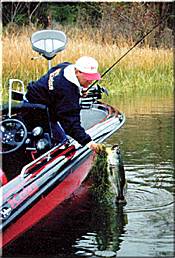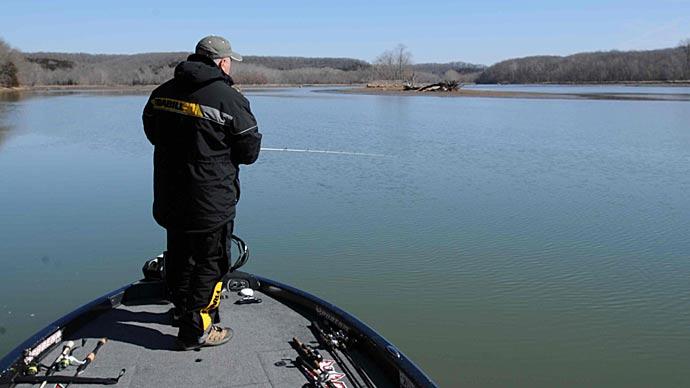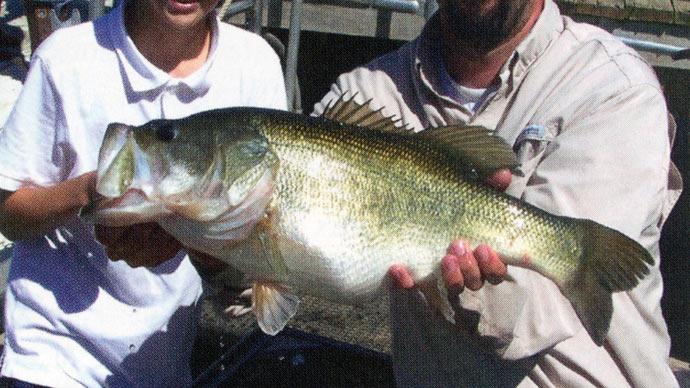
I have focused on Lake Fork in several articles in the past. One of the toughest was a review of the impact of the Largemouth Bass Virus, which struck the lake in the summer of 1999. It was just one year after the disease caused a significant die-off of bass in Sam Rayburn. The Rayburn experience was tough since I have had some of my favorite experiences with friends and my father on Rayburn. But the events on Fork were even more magnified since, by design, I spent at least two to three days a week on the lake during the summer of the infection. Seeing 4- to 12-pound bass slowly dying all over the lake was truly a depressing experience. This was a different situation for me than Rayburn in that I did not have to sift through the various (sometimes wild) explanations for the fish kill since I was there and observed it on Fork from the beginning. I had already written in our magazine that the kill on Rayburn had to be from a species-specific infectious agent, while others were ignoring the obvious and going after various explanations.
The events on Fork would be greatly appreciated in the following example. I had worked out patterns over the years that were constantly reproducible each year at that same time. I am a hot weather fan and had for years fished a couple of holes in the far upper reaches of the lake that held schools of 4- to 8-pound bass. You could catch 10 to 15 when you visit each of the sites. Even better was that they were in an area of the lake where fewer bass anglers fished and in shallower stained water where a crankbait would get appreciable attention.
I took my father to the holes in early May and let him catch ten fish. The guarantee was that the holes would only improve as we approached summer. My friend Jerry Dean wanted to make a film on Fork and set up an early June trip. My game plan was to catch fish in several places where you could catch singles and then as a fallback to the secret holes. The cameraman was instructed regarding his fate if he panned an area from which easy identification of the spots could be made.
Jerry and I have been fishing long enough to know that sometimes things work, and you easily catch fish, and sometimes you do not, despite your best efforts. But this was going to be a piece of cake. Our friend at the marina had warned us that it had been tough. However, I knew they had been there two weeks before, and I had left them alone to ensure my chance at TV stardom. Hole number one was without a strike. Hole number two finally gave up two fish after I had worn the paint off two cranks. I was a Zombie with my mind blown. Sure I wanted to make a good show, but what had happened in two weeks, and what did that foretell about the summer? In short, what had just happened on that trip could not have happened on Lake Fork at that spot and at that time of year.
To appreciate Fork before the die-off, let me explain the conditions for fishing. I do so with the background that I have been fishing this lake since it first filled, and every green tree had at least ten red wasp nests about the size of a basketball. The lake was billed as the next great bass lake in the United States. It was managed with regulations, which were supposed to ensure the peak survival of trophy bass, and was stocked initially with Florida bass to create the best gene pool for producing quality bass. The Sabine River Authority left much of the timber in the lake to make matters even better. This gave the developing bass population an excellent habitat from each year's hatch. Some areas were so thick with timber and brush that for the first five or so years, you would not be able to fish for bedding bass from a boat since you could not get back into the shallows due to the thick jungle. Thus major hatches of fry survived and flourished. There was also (as with most new lakes or reflooded areas of old lakes) excellent vegetation growth. The result of all of these factors was that the lake developed the best fishery I had ever seen. That is saying something because I fished Rayburn and Toledo from their inception; both were premiere lakes with excellent bass populations.
For whatever reason, the environment in Fork produced schools of large bass and a zillion schools of smaller fish. Whereas folks would talk about schools on Toledo Bend and Rayburn of two-pound bass, on Fork, the schools would often consist of four-plus-pound fish. These were not fishermen's tales, and the presence of such large populations of big fish resulted in a significant influx of visitors to the lake from all over the United States and even from fishermen outside of this country. The emphasis on size produced some interesting and oversized baits. Many guides would use an AC plug at certain times of the year to attract the giant bass. For those who may have missed its pass through history, this plug can be best described as a wooden plug consisting of a grooved lip that made it wiggle and two jointed sections best thought of as logs suitable for the fireplace. It discouraged strikes from anything but larger fish since its size would intimidate smaller bass.
So with that background, I chose to get a feel for the lake's present status from folks who make their living based on its fishery. These are the professional guides and marina operators. It does not make any difference how personable a guide happens to be. Most folks expect to catch fish, not just take a boat ride. Among the guides, I started with our lake columnist Dean Stroman. Dean could not have been more in line with my perspective on the lake if we had sung a duet. He stated that the lake was making a comeback but that he doubted it would ever return to anything close to the pre-virus days. His example was that it was common for most guides to put their clients on 25- to 40 fish in the pre-die off days, but now even the best guides work hard to approach 25 fish per day. He does have numerous 25 fish days, but that is still different than the ratio when he could practically be assured of 25+ fish on every trip in the good old days.
I wanted to ask each guide the same question regarding an identifier of the bass population in a lake. That was, "Do you see schools in the past two summers and thus far into the warmer weather this year?" As with my experience, Dean said he was only in a few places and no schooling in some of the old haunts where he and I witnessed the most dramatic die-off. The location where schools were more commonly seen last summer was on open lake points, and the schools consisted of five to 10 fish rather than the schools of 30+ fish seen before the kill. The other point that Dean made was that the small schools were made up of one- to three-pound fish rather than the roving packs of 4-pound and larger fish in the old days.
He also had a considerable concern regarding the impact of specific vegetation types on the backs of some coves. He felt that the total congestion threatened spawn areas in the sites, which certainly did not help bring back the population. Since I have ranted and raved positively in the past about vegetation, allow me to explain. If you get a thick surface covering vegetation during the spawn, you may risk total blockage of sunlight, which is a critical part of incubating the eggs. Likewise, if the stuff mats, you block out bottom-growing plants, and they die. The water hyacinth has one of the fastest growing rates of any plant and can divide in as little as 12 days. This means it has a doubling time, which results in it taking over areas in a relatively short time. This is of particular concern where the stuff is in backups and not subject to wind, which can raft it on windward sides and cause it to suffocate.
Dean also stated that the further up many of the feeder creeks you went, the harder the fishing became. This hurts since these were the premier bass havens before the kill, but it perfectly describes my "movie" hole. The other change that Dean acknowledged was the loss of the previously constant productivity experienced during the past years in the deep-water winter holes.
Another friend who has been a longtime guide on the lake is Hollis Joiner. Hollis and I go back a long way, so his opinion is one I will take to the bank. He told me that Fork was much better than the past few years but still had a long way to go to be where it was before the die-off. I had to ask, "Have you seen fish breaking during the summer in the past several years?" The answer was as if he and Dean had rehearsed their response. The same was true for the status of the upper ends of the major feeder creeks. Hollis indicated that some scattered fish were being caught in these areas, but as a guide, he had to concentrate on areas that were the most productive, which were on the main-lake portions. Hollis was also very concerned with water hyacinth and the fact that if it stayed thick, the spawning grounds would suffer, and if it were sprayed, the other water plants (that had been absent for several years in the same areas) might also die.
He was particularly optimistic regarding the fishery in that he was seeing some five- to eight-inch fish this spring which seemed to suggest a very late spring or summer hatch on top of the representatives he was seeing from the typical spring representation of last year's crop. Hollis noted that all the fish he and his clients were catching were healthy.
The second review of the status of Fork consisted of getting input from marina operators. I chose two of the more successful and long-term operators on the lake. Also, as with the selected guides, both of these guys will shoot straight. For input regarding the lower and mid portions of the lake, I visited Martin Edwards of the Minnow Bucket Marina. Martin started his business in 1984, so he has seen Fork from a historical perspective. He was hoping for some huge fish this spring but was happy to have many 10- to 11-pound fish caught. Interestingly, he noted that the folks from more open lakes, such as those from up north, were not having as much trouble finding fish as the locals following the die-off. He suggested this was because they were more attuned to open-water structure, and we had been spoiled due to the presence of considerable hydrilla in the lake and the style of fishing most of us developed to exploit the grass beds. He felt that local fishermen have, in many cases, not adjusted as well to the loss of grass (which in most parts of the lake occurred about the same time as the die-off). He is also very concerned about hyacinth because it can block out sunlight necessary for other bottom-attached water vegetation to grow and block sunlight from the nesting areas.
Interestingly, Martin does not believe the slot has a positive effect in that most bass fishermen do not keep bass under any condition. It is a real negative, as it impacts the very important clients from outside of Texas since, in many states, a six-pound bass is a giant. These folks pump a lot of money into the Fork economy but cannot legally bring a bass in the slot for weighing and pictures at a marina, although for them, it may be the bass of their lifetime. Martin said the guides who fought through the post-virus phase still have their following of clients. However, from his perspective, there are far fewer part-time guides, and quite a few folks have given up guiding. The cost of gas had not come into effect as of this spring, but he is concerned about its impact on the economy of the lake merchants if it stays up next spring, especially regarding those who come from long distances out of state.
My next source of information on the lake's status was Mr. Joe Axton, who owns Axton's Bass City on the upper end of the lake. Joe has an extensive motel/lodge complex and a large tackle store and hosts many tournaments on the lake. His story was similar to Martin's on the other end of the lake. This spring attracted more folks than the previous three springs. The client base consisted of folks from Ohio, Michigan, Mississippi, Missouri, and Nebraska, to name a few. Joe said that the lake was improving. Like Martin, he felt that a significant problem with those of us who were spoiled by working the hydrilla before the kill was a lack of willingness to be adaptive in fishing the changing fishery after the fish kill and the grass dies off. However, he echoed the story of the guides in that certain parts of the lake, like the upper ends of some of the major creeks, have not come back to the level that most guides even try to fish them.
We discussed a couple of my past favorite areas in the upper end, and Joe asked if I had ever thought that these spots were where most of the standing timber is still left and thus is where the major water turkey roosts are located. There were several years without much grass in these areas, and it is an interesting issue as to whether the thousands of birds gave any fry from that spring's hatch much of a chance to make it through the winter into the following year. These lovely birds are supposed to eat up to a pound of fish a day. If we have no grass in an area where the little bass could hide, and then take five thousand birds times the number of days each bird stays on the lake, times one pound of fish per day equals way too many pounds of fish eaten. Get the potential for a significant impact on the fishery?
Joe's story about schooling last summer was the same as the other guys. Gone are the large schools of four-pound+ fish. The small schools seen are usually made up of 10-inch or so fish. He has had excellent reports of 6- to 8-pound fish this spring, but not the huge bass he had hoped to see. He told me that the marina had a contest in which they would pay $1,000 for each 13-pound and over fish caught by a person who had registered with them and stayed at their facility. None have been brought into his marina during the last two years.
Joe believes the slot limit costs considerably in revenue stream for the marinas at Lake Fork. He noted that the number of guides on the lake has somewhat dropped but that the good guides still can produce 25+ bass in a day.
So what is the conclusion about the lake compared to the pre-virus time? From all of the input, it is improving each year. It has some hills to climb in. It is also an aging lake. However, if the hydrilla continues to flourish and the new hatches have reasonable survival rates, it will continue to be a top bass lake. It is not, and probably never will be, as good as before the virus-induced kill, but the re-stocking of Florida's in the lake may kick the gene pool in gear to provide some larger bass being present in five to eight years. It has plenty of shad for forage and is still a relatively good cover. However, my experience is the same as the folks I spoke with on the lake in that you would be wise to concentrate on the main-lake area until, or if, some of the older hot spots rebound.
Another thing about Fork is that more and more timber falls into the lake each year. The trees break at the usual water level; thus, with any rise, the lake will appear to have open water where there are vast numbers of stumps, even in deeper water.
So if you do not know where you are running, you are probably not in the marked boat cuts. Slow down for safety's sake.


